WAYFARING MAP: DOWNTOWN TO PROSPECT PARK
I had arrived in Prospect Heights, one of Brooklyn’s bounceback neighborhoods which has gone from rags to riches, with most of the rebuilding and refurbishing done since the 1980s after decades of disuse, drugs, crime and neglect. But even then the neighborhood had “good bones,” a housing stock from the mid-to-late 1800s, a golden age of architecture. Prospect Heights is a fairly large area wedged between the LIRR yards fronting Pacific Street, Flatbush Avenue, and Vanderbilt and Underhill Avenues. Much of it was built up following the development of Prospect Park and Brooklyn Botanic Gardens, which form its southern and southwestern boundary.
The economic slumps and racial problems of the 1960s and 1970s forced many longtime residents out and the classic buildings fell into disrepair after they were foreclosed by banks. Redevelopment commenced in the 1980s when the city began selling foreclosed buildings at reasonable rates to middle-class investors. Despite the real estate collapse of the early 2000s, investors in Prospect Heights have seen their properties increase in value by 15-t0-20-fold.
Having arrived at Pacific and Carlton Avenues, I wandered south on Carlton to ultimately return to Flatbush Avenue …
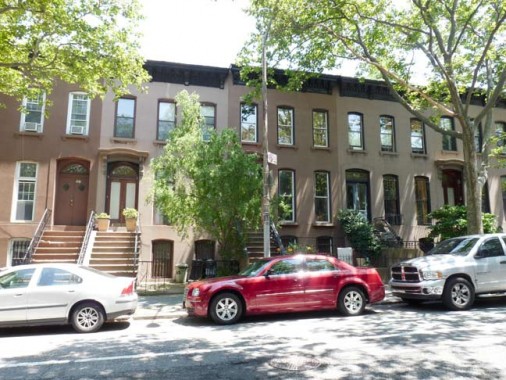
Carlton Avenue is named for the British Carleton House, the London residence of Henry Boyle (1675-1725) which briefly became the seat of British government until usurped by Buckingham Palace, which has a street named for it in Prospect Park South.
Here are a group of fine Italianate-style row houses built between 1869 and 1880 on the east side of Carlton Avenue near Bergen Street.
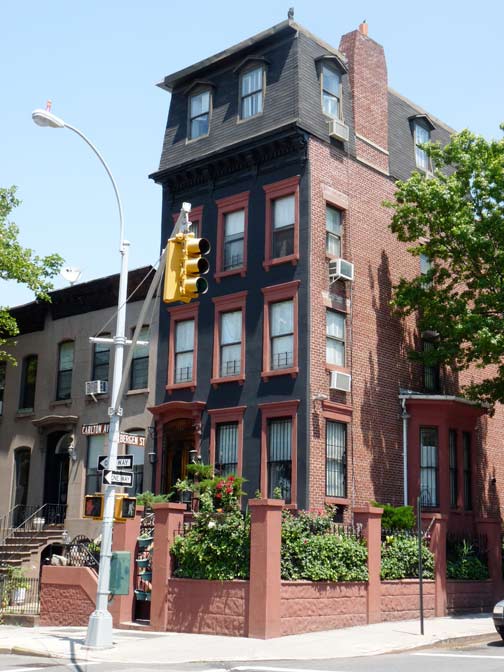
575 Carlton, on the corner of Bergen, was likely built in the 1870s with an extra floor than its fellows. The Second Empire style mansard was likely a decades-later addition.
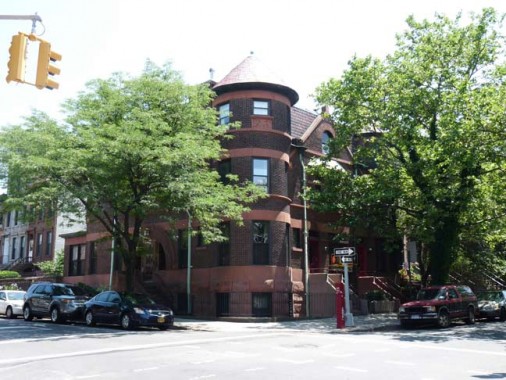
Across Bergen on the SE corner of Carlton is a series of united row houses built in 1892, with entrances on Bergen and Carlton. The corner turret is a hallmark of the Romanesque Revival style. Its carved stone panels, round-arched windows, and textured facades composed of brownstone and rough-faced brick impart an air of weighty personality.

Brick Italianate row houses on St. Mark’s Avenue and Carlton, built 1868-1872.
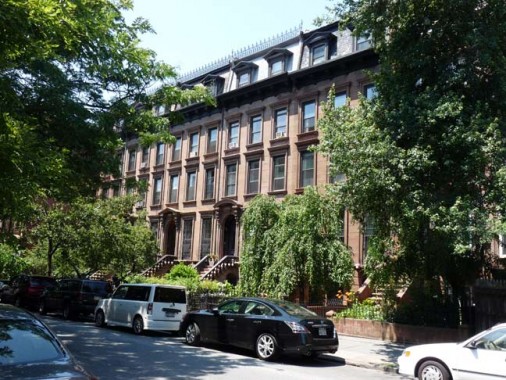
I just skirted past the borders of Prospect Heights but I did find some particular favorites such as this brownstone row consisting of six identical brownstones on Prospect Place between Flatbush and Carlton Avenues, built in 1873.
These Second Empire style buildings are characterized by stylized classical details with high brownstone stoops, round-arched pedimented entryways, heavily bracketed door surrounds, molded window enframements, and slate mansard roofs with pedimented dormers and prominent cornices. Although some doors and windows have been replaced, the row remains remarkably intact. NYC Landmarks Designation Report
This 4-story masterpiece is at 115-117 Prospect Place near Flatbush Avenue. Terra cotta heads, each with a different expression and adjacent symbolic design (but what are they? one is a 6-pointed Star of David) adjoin the ground floor windows. The LDC Report calls them “Byzantine ornaments.” It was built in 1889.
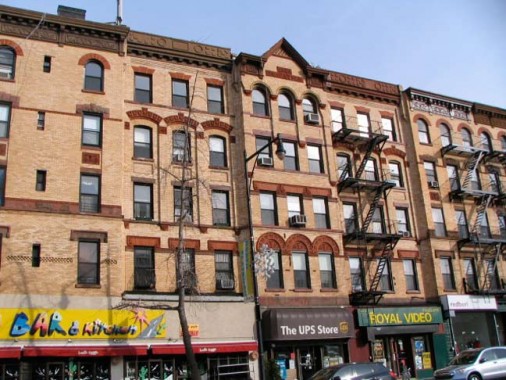
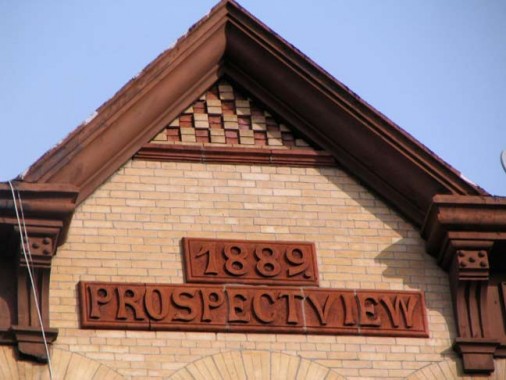
This group of row houses on the east side of Flatbush Avenue south of Prospect Place seems a little mundane, but keep looking up. You’ll see a cornice on one of them displaying the date of construction and building name in a sanserif, yet ornate font.
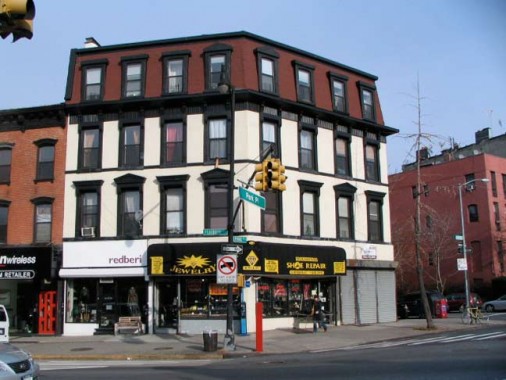
Mansard-roofed building wedged between Flatbush and Carlton Avenues and Park Place. It wasn’t till I had been frequenting these streets for decades that I deduced that Prospect Place and Park Place were named for… Prospect Park.
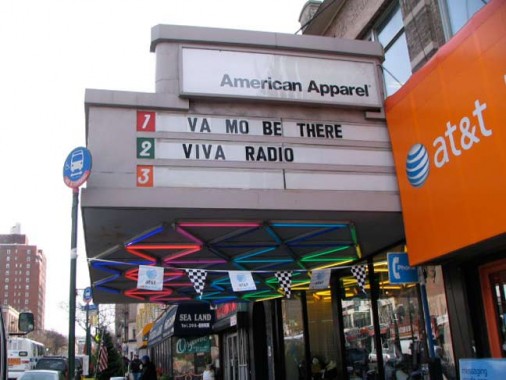
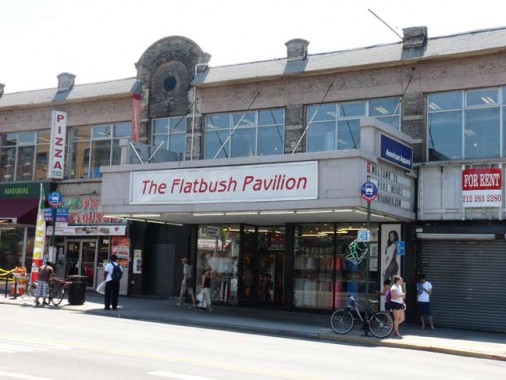
The Flatbush Pavilion, a.k.a. Pavilion Theatre, Flatbush and 7th Avenues, originally was a vaudeville and movie theater built by silent film comedian/impresario John Bunny in 1912. Beginning in 1940 it was called the Plaza, and later renamed the Flatbush Pavilion until its closing on May 22, 2004. The final features were “Man On Fire” and “Van Helsing.” When I had friends in Park Slope we would frequently catch films here.
Toward the end, though, the Pavilion didn’t have many fans:
The closing of this dive was a mercy killing. The place was a horrid place to see a film. The lobby was dark and dank; the auditoria were even more forboding. The film presentation was beyond bad. In a day and age of 6 channel digital sound, this place was still sporting a mono system in both rooms.
It was a scouting exhibition just to find a seat that wasn’t broken, and even those that were in decent shape were very uncomfortable. The screens were placed much too high making the viewing angle very hard on the neck muscles. Because it was twined, the rooms were long and narrow, giving you the feeling that you were in a tunnel. This shape was detrimental to speech intelligibility, which sank to near zero; it was a good thing they ran lots of foreign films so you could read the dialogue. cinematreasures
It’s now a branch of the ubiquitous American Apparel, whose ads are sometimes, er, arresting.
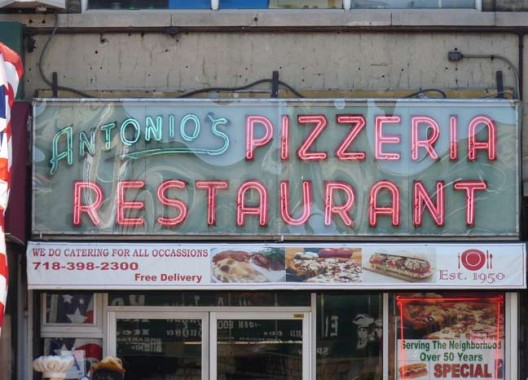
The original neon sign of Antonio’s, which opened in 1950 next to the theatre, still lights up.
Some eclectic store signs old and new along the east side of Flatbush Avenue. The Houti Couture thrift shop is named for its owner, model Alison Houtte.
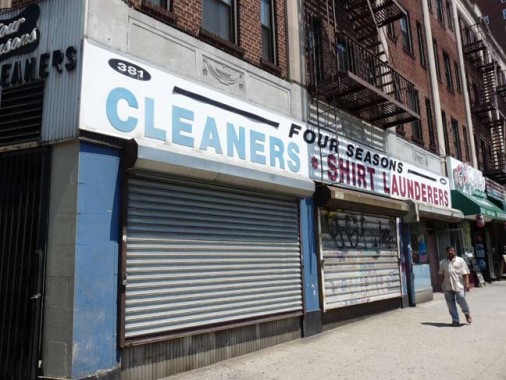
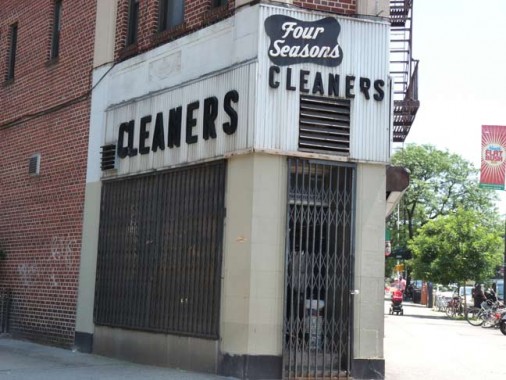
Four Seasons Cleaners has a classic sign on the sharp corner formed by Flatbush Avenue and Sterling Place.
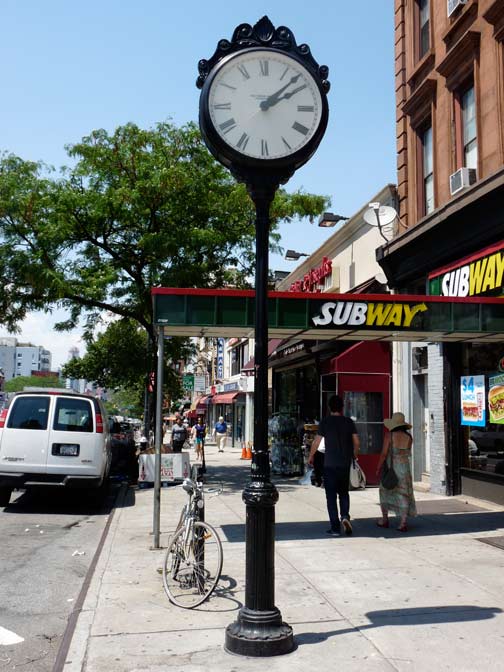
Flatbush Avenue sports two street clocks (the other one is at 6th Avenue) produced by Verdin in Cincinnati in 1982, mounted on Type B Henry Bacon park posts. This one met with traffic accidents in 1989 and 2006, but was ultimately replaced each time.
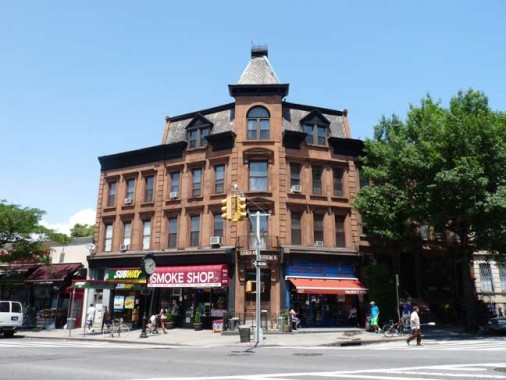
Impressive pair of brownstone buildings with slate rooves that form a unit with a corner tower at 375-379 Flatbush Avenue at Sterling Place. Each was constructed in 1885; architects at the time thought they were turning out humdrum, utilitarian buildings when they were really building things that would look straight out of the Magic Kingdom by 2013.
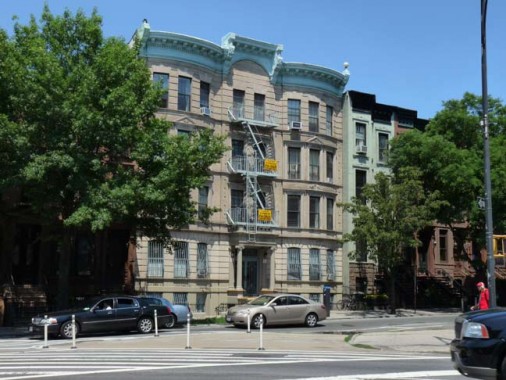
This 4-story tenement building, “The Majestic,” next door at 189 Sterling is actually one of the new kids on the block since it was built in 1903. You can tell that architectural styles were already getting a bit more streamlined even though this was smack in the midst of the ornate Beaux Arts period, whose buildings featured intricate sculptures and gewgaws.
Grand Army Plaza is where several important roads meet and is the northern end of Prospect Park. Flatbush Avenue runs southeast through the park to Rockaway Inlet; Eastern Parkway fans out east, getting as far as Bushwick; Vanderbilt Avenue runs north to Clinton Hill, and Prospect Park West stands in place of 9th Avenue as it borders the park and brings traffic as well as a controversial bike lane to Green-Wood Cemetery and Windsor Terrace.
Prospect Park’s engineers, Frederick Olmsted and Calvert Vaux, recognized this as an important crossroads and several memorials to the soldiers and their commanders who had recently fought and won the Civil War were built here. Residential architecture from the 19th through 21st Centuries is found along Plaza Street, which rims GAP’s border. The magnificent home branch of the Brooklyn Public Library, originally planned in the 1920s but actually built after World War II ended, and the Brooklyn Museum on Eastern Parkway mark its southeast quadrant.
One of the first monuments to the slain President John F. Kennedy appeared in 1965 at the north end of Grand Army Plaza. It replaced a large statue of Abraham Lincoln, the first slain President, which was then relocated deep in the park in the Music Grove, near the old Wollman Rink.
The bust, sculpted by Neil Estern, was originally poorly fitted on its pedestal and was then subject to vandalism. After several years’ absence, it was restored and replaced in August 2010.
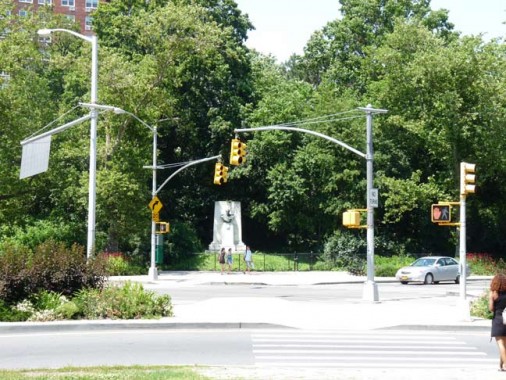
The bust of gynecologist Alexander Skene (1838-1900) occupies a prime spot facing Grand Army Plaza. Skene became an adjunct professor at Long Island College Hospital in 1865 and rose to president of the school, serving from 1893-1899. He was founder of the American Gynecological Society in 1866. He discovered the pair of para-urethral glands that are today called the Skene glands. After his death Scottish sculptor John Massey Rhind honored him.
A seemingly fat and contented Neptune, accompanied by tritons, allegoric male and female figures symbolizing wisdom and happiness, and an unnamed child are the dramatis personae in the Frank and Marie Louise Bailey Fountain, completed by sculptor Eugene Savage and architect Edgerton Swarthout in 1932. The fountain is spectacular in season when it is turned on and is surrounded by water jets.
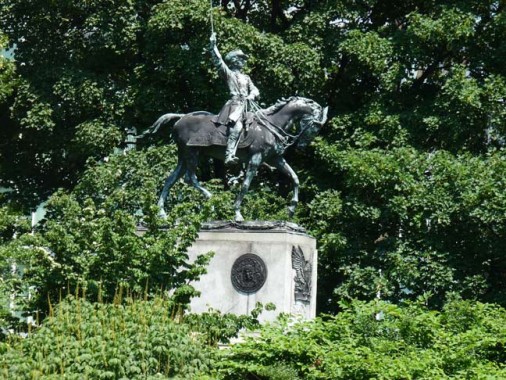
General Henry Warner Slocum (1827-1894) was a lawyer and politician in upstate Onondaga County before entering battle in the War Between The States; eventually attaining the rank of general, he commanded at Bull Run, Georgia, the Carolinas and Gettysburg. Moving to Brooklyn after the war, he was twice elected a US Representative, in 1868 and 1870.
Unfortunately Slocum’s name is most famously associated with a steamship tragedy in which over 1000 daytrippers, mostly from “Little Germany” Manhattan’s Lower East Side, perished in a June 1904 fire exacerbated by the incompetency of the ship captain as well as careless maintenance by the steamship company.
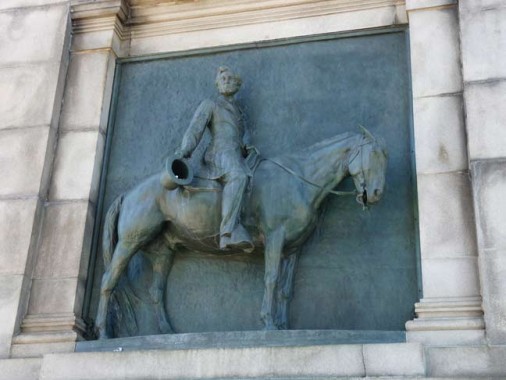
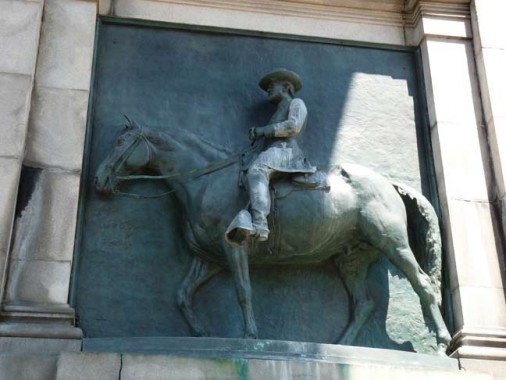
The triumphal arch at Grand Army Plaza, the Soldiers and Sailors Monument, needs no introduction…but there are a couple of tidbits about it that you may not have known. It does have a working elevator, for example, and there are two reliefs on the insides of the arch by artists William O’Donovan and Thomas Eakins, one of Ulysses S. Grant and one of Abraham Lincoln that is said to be the only known portrait of Lincoln on horseback. General William Sherman laid the cornerstone in 1889 and the arch was completed in 1892.
For details on all of the “guys” at Grand Army Plaza, see this FNY page.
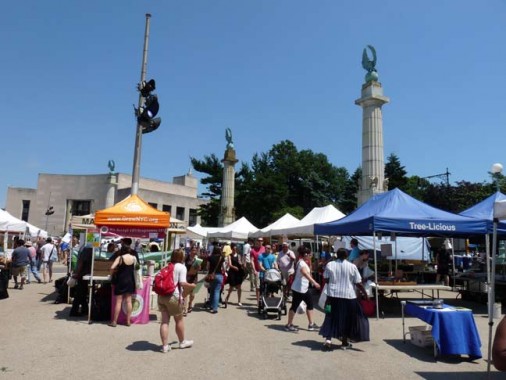
For over 25 years, Saturdays at Prospect Park West and Grand Army Plaza have been abuzz with a farmers market attracting producers and vendors from the five boroughs as well as Long Island, Westchester County, and New Jersey, and “locavores” desiring nutritious goods.
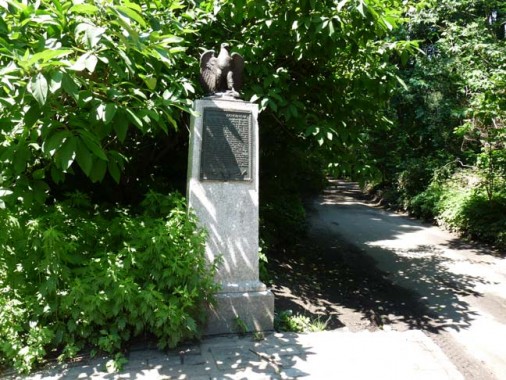
The Old Flatbush Road was here long before Prospect Park was ever conceived, and markers memorializing events of the Revolutionary War can be found along park roads.
In 1922 a monument featuring a plaque and bronze eagle was installed on an obscure park path near East Drive. A large white oak in this spot that was mentioned in a 1695 patent delineating the holdings of governor Thomas Dongan was cut down by the patriots and then laid across Old Flatbush Road to block the progress of British troops during the Battle of Long Island in 1776 — hence this is called the Dongan Oak Monument. The eagle has been stolen by miscreants twice, but restored each time.
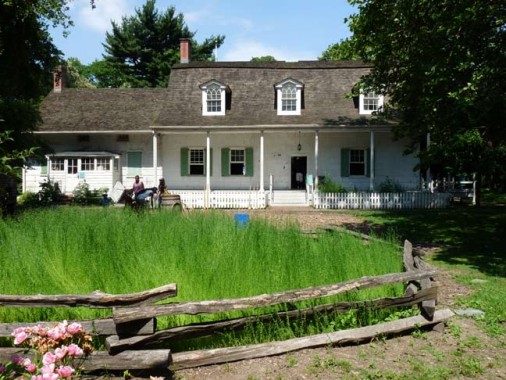
The Lefferts Homestead, near the park entrance at Flatbush and Ocean Avenues, is one of NYC’s many old Dutch colonial-era homes. It was built by the Lefferts family in an area east of the park along the Old Flatbush Road at about where Flatbush Avenue and Maple Street are now. Peter Lefferts had arrived in New Netherland in 1660 and had purchased a farm in this area in about 1675, and passed the property on to his son John.
On August 23, 1776, British forces engaged American rebels in the area near the farm. Rather than allow the British to occupy the house, the rebels burned it to the ground (the family had already left town to escape the anticipated British invasion). John Lefferts died a couple of months after that, and his family set to the task of rebuilding the farmhouse. By 1777, John’s son Peter had produced this gabled, shingle-roofed building featuring a 6-columned porch and dormer windows; the Lefferts family continued to occupy it until 1918, when the City took it over and moved it to its present location. It’s presently used as a childen’s museum, complementing the larger one in Bedford-Stuyvesant. During the year, there are sheep shearing exhibitions a swell as Dutch and African-American festivals. The building also features a rather eclectic library: on one visit, I found a long-out-of-print book produced by the Bay Ridge Historical Society, “Bay Ridge Chronicles,” detailing the history of my own home neighborhood.
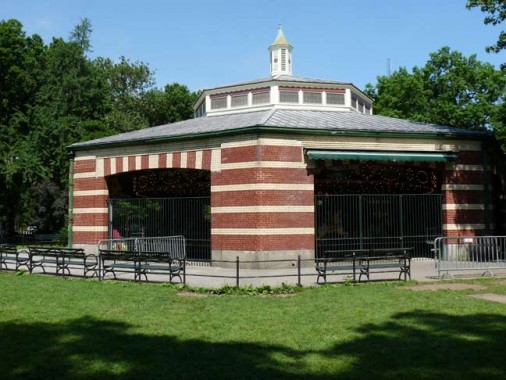
Just to the rear of the Lefferts Homestead you will find the Prospect Park Carousel, built in 1951 but containing parts of two earlier designs by Charles Carmel going back to 1915 and 1918. Note the lion, giraffe and deer mixed in with the 51 painted ponies. This carousel is the fourth in a series of Prospect Park carousels dating back to 1874, 1885 and 1915 respectively. The day I was by, the festive carousel music was featuring the Swinging Sixties hit “Georgy Girl.”
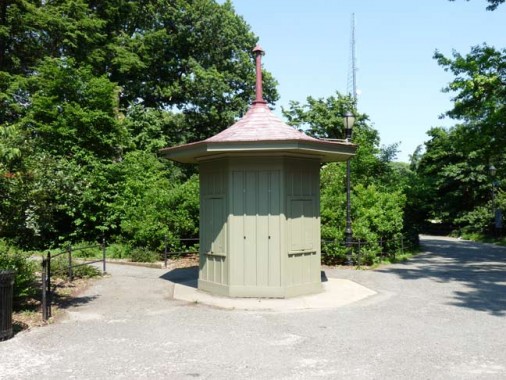
Near the carousel is an early version of a tollbooth that used to collect fares on the old Flatbush Turnpike, which generally followed the route of the Old Flatbush Road and today’s Flatbush Avenue, from the colonial era until NYC consolidation in 1898, when Brooklyn, Queens and Staten Island joined Manhattan and the Bronx as the five boroughs we know and love today. The one here became a backyard garden structure when it was removed by an area resident and placed on his property. A subsequent homeowner in the 1950’s realized what he had in the backyard and contacted the City’s Parks Dept. It was restored (it is mostly wood) and placed in its current location which is not far from its original position.
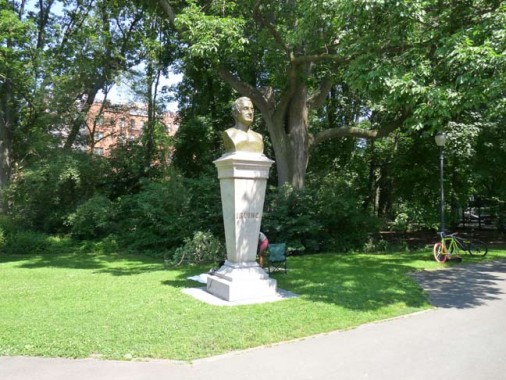
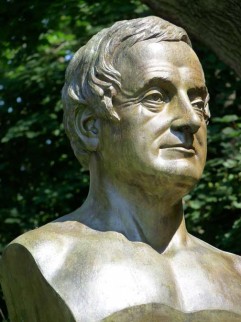
A bronze bust of author Washington Irving can be found on East Drive as it passes the Oriental Pavilion. It was sculpted by James Wilson Alexander MacDonald and dedicated in 1871.
In “Brooklyn Public Monuments,” the author Elmer Sprague writes that the impetus for the monument came from a Brooklyn man, Demas Barnes, “a private citizen, noted for his liberality.” Barnes’s hope was, according to Sprague, that the statue would be “‘the nucleus of an art collection’” in the park. You could argue his hope came true; nearby are half a dozen other statues [mostly classical composers and musicians, in the Music Grove]. New York City Statues
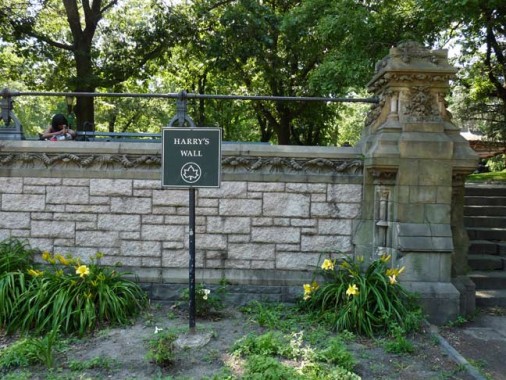
Harry’s Wall, also near the Music Grove on East Drive, commemorates the founder of the Prospect Park Track Club, Harry Murphy (1914-1993), a postal service worker, graphic designer and historian in addition to being a world-ranked runner. Harry’s Wall was dedicated in 1995.
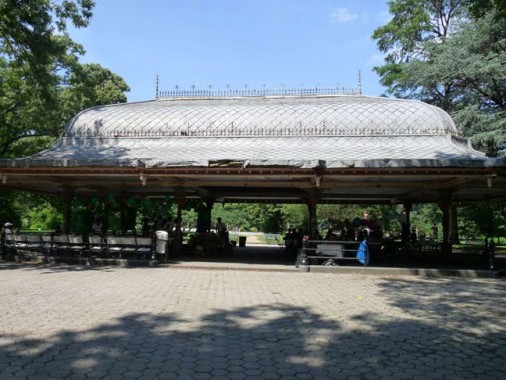
I’ll leave off at the Oriental Pavilion, the centerpiece of the Music Grove. The Pavilion was completed in 1874 and consists of eight cast iron posts, painted colorfully in a vague Middle Eastern pattern, supporting a complex roof that flares outward on the edges, creating a large shady area. The Pavilion originally looked out over the adjoining Concert Grove, so parkgoers could sit under it on those hot sunny days and enjoy the brass bands. Robert Moses constructed a snack bar under the pavilion in the early 1950s, which burned down in 1974, taking the pavilion along with it, but happily, it was rebuilt in 1987. It could use a touch-up by now, however. Stand under it for some stained-glass views on the roof.
8/11/13


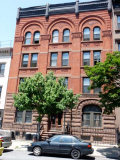
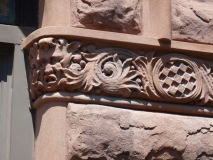
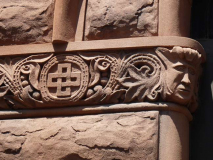

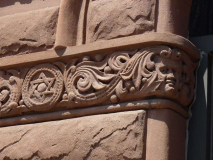
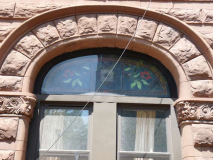
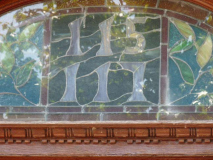


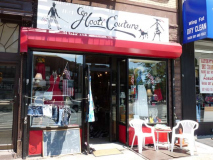

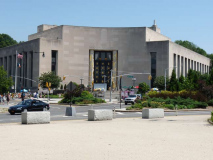
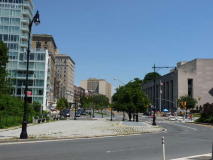
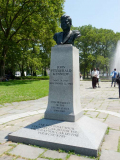
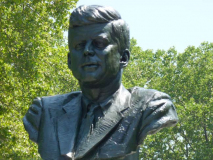
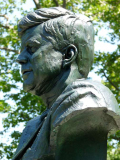
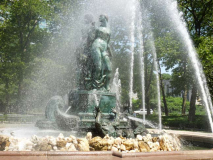

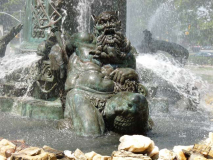
11 comments
I had trouble finishing the post after the blinding insight that corrupted my corneas.
Thank you
Do you plan on doing the rest of Flatbush Avenue all the way down to Marine Park or are you stopping it here?
I shot Flatbush between Church and Bklyn College — I have yet to use them
Sorry Kevin, but your pic clearly shows a six pointed Mogen David (Star Of David) which is the only original “Jewish Star.” Like you ( I assume, please forgive me if I am mistaken,) I am an Irish Catholic but grew up in (what was then) largely Orthodox Jewish Crown Heights and Bed Stuy. Most of my friends were Jewish kids from the neighborhood synagogues and African-American kids whose parents were deacons or preachers from thhe local churches. That was where I learned to love Gospel music.
Jim,
You are correct. The six-sided Magen David (shield of David) is the ancient symbol of King David and later became a symbol of Judaism, by extension
Todd
You must really love those dry cleaner stores with mid-20th C. signs, don’t you? Plastic theater-marquee-type lettering on a corrugated background– first, the one in Chelsea last week, and now, this one.
PS, love the carousel photo. Spare, but still stylish in its way nonetheless– without, as you would put it, the “gewgaws” from the Boz(o) Arts era. Its form fairly shouts, “carousel,” and surprise surprise, it houses a carousel. Elegantly understated, like those Italianates which say, “townhouse for those who don’t feel a need to impress everyone with a lot of ‘wedding-cake’ nonsense.” (I wouldn’t hire Buddy Valastro to design the exterior of my home, you may have gathered.)
I remember riding the Prospect Park Merry-Go-Round as a kid. My dad told me that he used to be able to reach out and grab a brass ring, but that feature had ended by the mid-50’s.
You wonder at the Star of David ornaments at 115-117 Prospect Place. The Grace Methodist Church at 38 7th Ave has a Star of David over each window embrasure down the side of the building. E.g. http://tinyurl.com/mgab742 It seems to have been a popular ornament before 1900 in the area, at least.
Park Slope/Prospect Heights used to be the big center of Jewish Brooklyn back before WW1. They had a Y, many synagogues. The area was built up by 1900, and had good public transit via 3rd/5th Ave els and 7th/9th Av/9th St streetcars to the Brooklyn Bridge. But it’s probably a coincidence that there are Stars of David on a church. On a brownstone row – well, who was the developer?
See Abelow, “History of the Jews of Brooklyn”, 1937 http://tinyurl.com/mycxke3
Skene summered in Fleischmanns, NY, where the town library is named for him. For another Brooklyn connection, the old synagogue up there was founded by (among others) my great-grandfather Louis Cohen, who also founded the Brooklyn Jewish Center. He also vacationed in the area, either in Fleischmanns or nearby Pine HIll (other side of the mountain), with the 9 children. The same local builder built both the library and the synagogue, 20 years apart.
http://en.wikipedia.org/wiki/Congregation_B'nai_Israel_Synagogue
The main branch of the Brooklyn Public Library was opened in 1941, I believe, not after WW II.
Your journeys’ transferred the smells, sounds, love and safety of my young childhood; like Heaven itself! I love the amazing history and images you have documented reflecting your warm appreciation.
I just stumbled on your site looking for my 1st home on 164 Prospect Place, c. 1960. We lived on the ground floor and I would be put through the window to play in the back by the carriage house. Do you have any pics of that or is it dismantled? And the carousel at Prospect Park! And Bailey’s Neptune Fountain is like a long lost dream! Haha! I moved to TN in 1973 and am torn between two homes! Thank you again!
Lynda